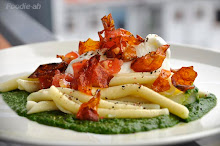Monday, August 30, 2010
My favourite restaurants #1
Every time I reflect on where I ate and what I should recommend. I thought it would be a good foodie's practice to record his favourites periodically and publish them every 3 months or so. The following are my favourites as of today.
Japanese
- Wahiro - Good value for money sushi, and great traditional, seasonal dishes
- Goto - Best kaiseki
- Matsuo - Best top end sushi
- Shimbashi soba - Best soba
Ramen
- Keisuke - Great for seafood based broth
- Marutama - Great chicken stock
Chinese
- Silk Road - My favourite northern Chinese food. Shaved noodles, Dandan mien, French beans...
- Shin Yeh - Taiwanese bottarga, fish claypot with tofu and aubergines
- Lan Zhou La Mien - Zhajang mien, guo tie
Classic French
- Cocotte
- Le Bistrot du Sommelier - Frog legs, Cote de Boeuf
Italian
- Cugini - Linguine alle vongole, ravioli, pizza
- Gattopardo - Bucatini alle sarde, arrotolata, zuppa di pesce, crispy bread
- Forlino
Fine dining Lunch Menus
- Fiftythree - I love their bread and starters
- Private Affairs - Really great deal, great food
- Gunther's - Gunther's style is worth a try
- Tippling Club - Inventive molecular cuisine, great desserts and cocktails!
Sunday, August 29, 2010
Bucatini alle sarde
Unfortunately I don't yet have wild fennel available here in Singapore, so I had to make do without it. I have ordered the seeds from Sicily, and I am planning to cultivate it myself in my herb garden. I will make this again when I will finally have one of the main ingredients. Said that, I can guarantee that this pasta tasted just as excellent without the wild fennel, despite missing one layer of flavour.
In order to add some colour to the pasta I replaced the wild fennel with Italian parsley, since that's what I had in the fridge. I bought the sardines frozen from Liang Court at S$12.80 for 6. A pretty good deal! The bucatini can also be purchased at Liang Court. All other ingredients are commonly available at any supermarket.
The complete list of ingredients is:
- 3 sardines
- 1 large red onion
- 1 anchovy
- a handful of breadcrumbs (I use Japanese 'panko')
- a couple of tablespoons of pine nuts
- a couple of tablespoons of raisins
- a pinch of saffron
- wild fennel (if you are in luck), or alternatively some fresh Italian parsley
Put the raisins in warm water and let them soften, the longer the better. Remove the heads and tails from the sardines, split them into 2 lengthwise and remove the innards. Carefully extract the spine and as many of the little bones as you can. Put the heads and bones into a small skillet, quickly fry them in olive oil and top them with a glass of water. Bring to the boil, then simmer over low heat (if you happened to have some fennel, I think a few chunks of it would hugely benefit this quiuck stock!). Wash the sardines, sprinkle them with salt and set them aside.
Bring a large frying pan to medium heat, then pour the fresh pine nuts onto it. Gently keep shaking the pan, rolling the pine nuts until they are nice and golden on both sides. Put them back into a small bowl. Repeat the same operation with a handful of 'panko' (breadcrumbs), until from yellow they turn light brown and crispy. Remove from the pan and set aside.
Pour generous olive oil into the same pan, and fry the sardines skin side down first for a minute over medium heat, then turn them to the other side and cook for another 30 seconds. Remove from the hot pan with a large spatula, paying attention not to break them. It is in fact important that your pan is not a non-stick one (as pictured, a solid metal pan is the best choice). Raise the heat to high, then deglaze with a splash of white wine. The reaction should create a cloudy, creamy sauce.
Reduce the heat to medium, pour in the finely chopped onion and keep stirring until it slowly browns. In the meantime, bring a large pot of water to the boil for the bucatini. When the onions are nicely golden and reduced, dissolve a pinch of saffron and the anchovy into half a glass of the boiling water, then pour into the frying pan together with the onions. Also add the raisins, the pine nuts and the whole parsley stems, unchopped.
Salt the boiling water and add the bucatini. Put some of the sardines into the pan which should now be on low heat and reserve a couple of them for decoration. In the meantime, strain the stock which you have been simmering on the side with a fine sieve, and gradually add it into the pan as more juices are needed.
When the bucatini are ready (follow the directions on the packaging), drain them and put them into the sauce pan. Mix well, then top up with some toasted breadcrumbs and freshly ground black pepper. Make sure that there is enough juice in the pan when you add the bucatini (see pictures), and add either some of the stock or some of the bucatini cooking water to maintain the right level of juiciness.
Place a portion of bucatini on each plate, then top with some of the onions sauce, juices, decorate with 1-2 sardines and sprinkle with additional breadcrumbs and pepper.
I had this pasta at Gattopardo, and really liked it. I must say I enjoyed mine just as much despite the missing finocchietto, but hopefully I will be able to grow that successfully.
Grapefruit Campari
- 1 large grapefruit
- 100ml Campari
- 50ml Cinzano dry (or Martini dry)
- 3-4 pink peppercorns (optional)
Peel the grapefruit, remove all the peel/white parts and put all the flesh into a blender. Add the Campari, Martini and optional peppercorns. Blend at high speed for about 3 minutes, until it's well blended and foamy. Pour the mixture into a shaker with a generous amount of ice, and shake until the mixture is ice cold. Gently pour into a Martini glass.
Saturday, August 28, 2010
Cocotte






The citron tart was well presented, but I wouldn't judge it since I never like lemony desserts. I can just say that everybody else enjoyed a little taste of it.

On the other hand, I had most of the apple tart tartin, which was topped with a scoop of smooth vanilla ice cream (removed before taking the picture). The dough was crumbly and thin, topped with chunks of cooked apple. I always prefer non-fruity flavours on my desserts, so this wasn't my favourite dessert, but it was well put together.
Cocotte
2 Dickson Road, Wanderlust Hotel Singapore
Tel: +65 6298 1188
Sunday, August 22, 2010
Lobster Fettuccine

For this recipe you will need the following ingredients (for 2 people):
- 1 x 600-700g live lobster
- fresh basil
- fresh parsley
- 6 mini plum tomatoes
- 50ml dry white wine
- 10ml white vermouth
- 2 cloves of garlic
- Chilli flakes
- black pepper
- a small piece of butter (optional)
- 1 onion and 1 celery stalk

Remove the skin from the plum tomatoes, cop them and sprinkle them with salt (make an incision, boil them for 20 seconds and quickly place them into ice water to facilitate the operation). Add the skins to the stock pot. Crush a couple of cloves of garlic. Give the stock about 20-30 mins to get some flavour, and enrich with some fish stock if you have it. Remove from the fire, filter and set aside.

Pour some olive oil into a large frying pan, then quickly fry the lobster meat cut into large chunks. 30-40 seconds should be sufficient for it to be cooked and retain its juices. Remove the meat from the oil, then add the garlic and chilli and fry them until golden. Pour the wine and vermouth and deglaze the pan. Reduce to a half, then add 2/3 of the tomatoes and pour about 200ml of the lobster stock. Reduce to a half, then add 3/4 of the parsley and turn off the stove.
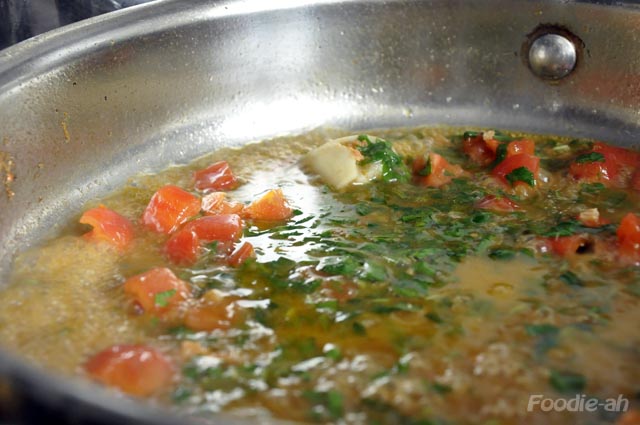
In a pot of boiling water, cook the fettuccine for a couple of minutes (read the cooking instructions on the pack), then drain them, put them into the frying pan and complete the cooking for another 2-3 minutes together with the remaining chopped tomatoes, parsley and basil, adding more stock and salt if necessary. Melt in the optional knob butter if you prefer the sauce to be more rich.
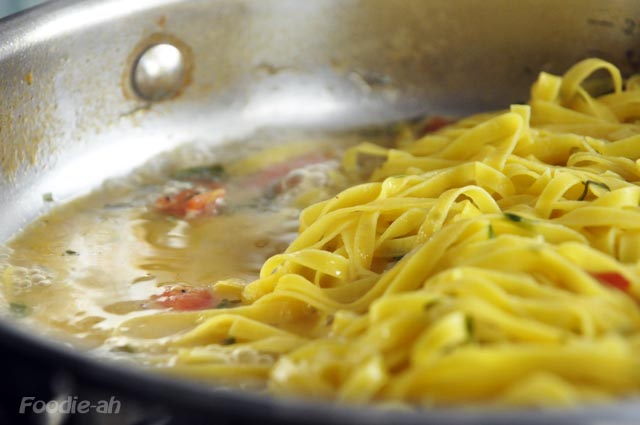
Finally place the fettuccine on a plate, top with some fresh parsley and basil, pour a gentle amount of sauce and arrange the lobster meat on the side. Sprinkle with black pepper.
Friday, August 20, 2010
Gattopardo
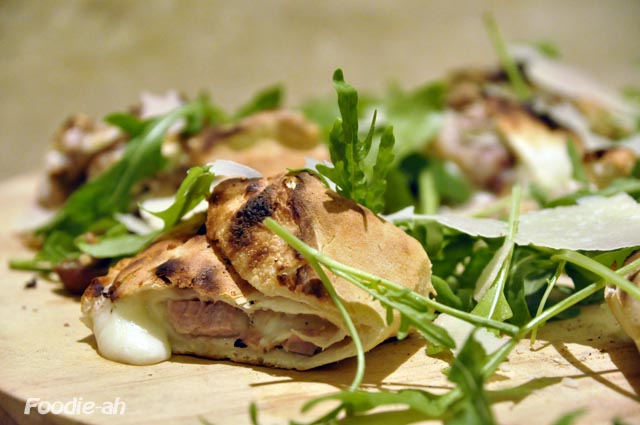 The Arrotolata (S$24) is a rolled up pizza, stuffed with Smoked Mozzarella, Suckling Pig, Porcini Mushrooms, Grape Sauce and topped with fresh Rucola Salad. Great balance of quality ingredients, plenty of cheese oozing out of the pre-cut slices and abundance of fresh rocket to lighten up the flavour. The texture of the dough is not as dry as other pizza restaurants I tried in Singapore, leaning towards the southern Italian/Neapolitan style.
The Arrotolata (S$24) is a rolled up pizza, stuffed with Smoked Mozzarella, Suckling Pig, Porcini Mushrooms, Grape Sauce and topped with fresh Rucola Salad. Great balance of quality ingredients, plenty of cheese oozing out of the pre-cut slices and abundance of fresh rocket to lighten up the flavour. The texture of the dough is not as dry as other pizza restaurants I tried in Singapore, leaning towards the southern Italian/Neapolitan style. Even more impressive was this traditional Sicilian style bucatini (S$26). Most Italian restaurants tend to serve the usual "standard" Italian pasta dishes (whether they really are as they are meant to be), and just stick to those to be safe. It is rare to find real regional pasta dishes on a menu. Gattopardo is one of those rare restaurants, as they sourced the hard to find ingredients to serve something you would not find elsewhere. Wild fennel, fresh sardines from the Mediterranean, roasted pine nuts, saffron and raisins. It sounds like a very rich combination, but in actual fact the result is extremely well balanced. I can count on one hand the times I was as delighted to enjoy the essence of well executed regional Italian cuisine here in Singapore.
Even more impressive was this traditional Sicilian style bucatini (S$26). Most Italian restaurants tend to serve the usual "standard" Italian pasta dishes (whether they really are as they are meant to be), and just stick to those to be safe. It is rare to find real regional pasta dishes on a menu. Gattopardo is one of those rare restaurants, as they sourced the hard to find ingredients to serve something you would not find elsewhere. Wild fennel, fresh sardines from the Mediterranean, roasted pine nuts, saffron and raisins. It sounds like a very rich combination, but in actual fact the result is extremely well balanced. I can count on one hand the times I was as delighted to enjoy the essence of well executed regional Italian cuisine here in Singapore. The Ravioli con Burrata e Crescione (S$26) was also very good. The flavour of the burrata was very intense when biting into these ravioli. The watercress sauce was creamy with finely chopped watercress and parsley and a dash of stock to enhance the flavour.
The Ravioli con Burrata e Crescione (S$26) was also very good. The flavour of the burrata was very intense when biting into these ravioli. The watercress sauce was creamy with finely chopped watercress and parsley and a dash of stock to enhance the flavour. I was not as impressed by the Cipolle di Tropea e Ragusano (S$18), an onion pudding served with a Ragusano cheese fondue. The cheese itself was deliciously intense, but the pudding didn't have sufficient flavour to contrast it. I would have expected it to distinctly taste of slowly braised onions, but the onion taste was really just shying in the background.
I was not as impressed by the Cipolle di Tropea e Ragusano (S$18), an onion pudding served with a Ragusano cheese fondue. The cheese itself was deliciously intense, but the pudding didn't have sufficient flavour to contrast it. I would have expected it to distinctly taste of slowly braised onions, but the onion taste was really just shying in the background.
Gattopardo Italian Grill & Pizzabar
Fort Canning Hotel
11 Canning Walk, S(178881)
Tel: (+65) 6338 5498
Website: http://www.gattopardo.com.sg
Monday, August 16, 2010
Jewels Artisan Chocolate - Mooncakes

Let's start with the classics. The baked double yolk mooncake was indeed very good, since the yolk itself was dry and salty, creating a contrast of texture with the soft and sweet lotus paste. Definitely one of the best I had to date.

The baked mooncake with black pearl chocolate and winter melon seeds was my favourite out of the three, due to its uniqueness. I loved the combination of the crunch from the winter melon seeds and the bitterness of the dark chocolate. This is tradition with innovation. After all, why would you come to Jewels, if not for something unique and innovative?

Finally, the single yolk and black pearl chocolate mooncake. Note that the single yolk has been gently squeezed to flatten it across the whole surface, just so that none of those you will be sharing it with will remain disappointingly yolkless! Once again, nice contrast of texture, with a bit of a modern twist.

Now, coming to the snowskin mooncakes... Last year, after many disappointments with snow skin mooncakes, I made a promise: I would only buy snowskin from the Raffles going forward. I have really tried about 6-7 different ones, and despite the fact that the price doesn't vary significantly, I only had bad experiences when eating snowskin other than the Raffles ones. Therefore, after so many attempts, I decided I wouldn't waste my money ever again.

A year later, I know I won't be maintaining my promise. After all, the head chef at Jewels has been making mooncakes at the Raffles for many many years, so it's not that surprising that hers are at the same standard! The mini snowskin with white chocolate ganache is as good as it can get. This is the "classic"out of the 4 varieties, and the beauty is that the white chocolate inside has not been sweetened with sugar, to create more balance between the already sweet lotus paste and the truffle core. To those who got acquainted with such bad practice, no more excuses for leaving the paste and eating the truffle on its own!

The dark chocolate crunchy pearl has a palate teasing crunch to it, as the name suggests, and a mild minty aroma. It's like eating a very mild after-eight in mooncake form, with more crunch. Those who have tried the Pearl Noir signature chocolate from Jewels, will recognise these little pearls. Those who haven't, should really taste what eating a perle noir is like. The espresso truffle mooncake has a very distinct and robust coffee taste, and will be the favourite for anyone who loves their coffee.
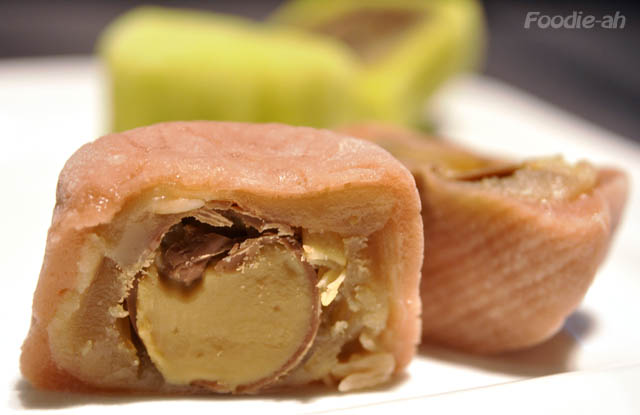 Finally, the last one of this year's selection is my favourite: the salted caramel truffle. If you like the salty-sweet combination or you like salted caramel, then this is a must try. The core is uniquely salted with gentle and smooth palm island seasalt, and as you bite into the truffle, you can feel the saltiness oozing out of it, later balanced by the sweetness of the lotus paste. The lemon seeds add that traditional element of crunchiness to the whole experience.
Finally, the last one of this year's selection is my favourite: the salted caramel truffle. If you like the salty-sweet combination or you like salted caramel, then this is a must try. The core is uniquely salted with gentle and smooth palm island seasalt, and as you bite into the truffle, you can feel the saltiness oozing out of it, later balanced by the sweetness of the lotus paste. The lemon seeds add that traditional element of crunchiness to the whole experience.Well, what else can I say... I have already pre-ordered my assorted box!
Website: Jewels Mooncakes
Sunday, August 15, 2010
Strozzapreti alla Caprese
I like recipes that are created out of craves, when the ingredients are selected out what's available or what you really want to have. That has been the case with my past few pasta recipes, and definitely the case with this one. I was looking for a more robust texture, so I chose these strozzapreti "Rustichella d' abruzzo", which you can find at Liang Court.
 I was craving again for these Italian fresh tomatoes which I blogged about in my previous few posts, and I wanted to make good use of my ever growing basil plants. I decided to combine these classic Italian flavours into a new pasta recipe, which I called "Caprese" for obvious reasons.
I was craving again for these Italian fresh tomatoes which I blogged about in my previous few posts, and I wanted to make good use of my ever growing basil plants. I decided to combine these classic Italian flavours into a new pasta recipe, which I called "Caprese" for obvious reasons. For this recipe (2 servings) you will need:
For this recipe (2 servings) you will need:
- 8 Italian mini plum tomatoes
- 170g pasta
- A lot of fresh basil (about 2 packs if you are buying it from the supermarket)
- 180ml chicken stock
- Some fresh buffalo mozzarella
- Garlic
- Pink peppercorns
- 6 fresh green peppercorns (optional)
 As described on my previous recipes, remove the skin from the tomatoes by making a superficial incision on them (I cut a cross at the bottom of each tomato), then blanching them in boiling water for about 20 seconds and then immediately placing them into ice water. The skin should break apart and come off easily. Reserve the skin, then deep fry it in a small skillet where you have brought hot oil to the right temperature (about 180C). Remove the tomato skin from the oil when it starts to darken, dry out and crisp. Wrap it loosely into a couple of sheets of kitchen paper, which you then seal with your hands and shake repeatedly to let the oil be absorbed by it. Set aside.
As described on my previous recipes, remove the skin from the tomatoes by making a superficial incision on them (I cut a cross at the bottom of each tomato), then blanching them in boiling water for about 20 seconds and then immediately placing them into ice water. The skin should break apart and come off easily. Reserve the skin, then deep fry it in a small skillet where you have brought hot oil to the right temperature (about 180C). Remove the tomato skin from the oil when it starts to darken, dry out and crisp. Wrap it loosely into a couple of sheets of kitchen paper, which you then seal with your hands and shake repeatedly to let the oil be absorbed by it. Set aside.
Chop the plum tomatoes into small dices (about 6-8 pieces per tomato), then sprinkle with salt and set aside. Blanch the basil in boiling water for 15 seconds, then again in ice water. drain it well, place it into a tall container with a tiny amount of finely chopped garlic, optional green peppercorns and some salt. Pout 2 tablespoons of extra virgin olive oil, then whizz with an immersion blender for a good 5 minutes, until it is reduced to a smooth cream of basil. You might need to add some olive oil to reach the right texture, but the end result should be solid and not viscous.
Blanch the basil in boiling water for 15 seconds, then again in ice water. drain it well, place it into a tall container with a tiny amount of finely chopped garlic, optional green peppercorns and some salt. Pout 2 tablespoons of extra virgin olive oil, then whizz with an immersion blender for a good 5 minutes, until it is reduced to a smooth cream of basil. You might need to add some olive oil to reach the right texture, but the end result should be solid and not viscous.
While the pasta is boiling, heat up some extra virgin olive oil in a large 28cm frying pan, fry 3 squashed garlic cloves until golden, then remove them. Add the stock, cover immediately and remove from the heat. When the strozzapreti are almost ready (I counted 12 minutes), put the frying pan back on the fire, drain the pasta and pour it into the frying pan together with 1 tsp of salt. Saute' the strozzapreti for a couple of minutes, until the stock is absorbed and you are left with a few tablespoons of sauce at the bottom of the pan.
Finally, arrange the basil cream circularly at the bottom of a warm plate, place the strozzapreti in the centre, then top with a chuck of buffalo mozzarella, the diced fresh tomatoes and the tomato skins. Pour a tablespoon of the sauce left in the pan onto each serving, then sprinkle with the crushed pink peppercorns and serve hot.
Saturday, August 14, 2010
FiftyThree - Lunch #2
 I once again decided to have the 3 set course lunch priced $53 (what a coincidence!). The items on the menu were more or less unchanged as last time I visited it, and I was glad that the bread was exactly the same, since this is what I went for! We had a double portion of the milk and charcoal bread. Filling, but well worth it!
I once again decided to have the 3 set course lunch priced $53 (what a coincidence!). The items on the menu were more or less unchanged as last time I visited it, and I was glad that the bread was exactly the same, since this is what I went for! We had a double portion of the milk and charcoal bread. Filling, but well worth it! Presentation is always great at FiftyThree. This appetizer was beautifully presented in syntony with their "nature theme". I liked the walnut cream and the crab meat, although I left most of the apple slices since I preferred the crab simply on its own.
Presentation is always great at FiftyThree. This appetizer was beautifully presented in syntony with their "nature theme". I liked the walnut cream and the crab meat, although I left most of the apple slices since I preferred the crab simply on its own. The beef was absolutely great, tender and juicy, and the sauce was poured onto it right at the table.
The beef was absolutely great, tender and juicy, and the sauce was poured onto it right at the table. We had the lamb again since we liked it last time: a rare lamb rump cut into juicy slices, arranged below thin and crispy slices of radish.
We had the lamb again since we liked it last time: a rare lamb rump cut into juicy slices, arranged below thin and crispy slices of radish. We also repeated the dessert, since it was one of the two reasons for coming back. Pretty high-calories, but well worth it.
We also repeated the dessert, since it was one of the two reasons for coming back. Pretty high-calories, but well worth it. This second visit at FiftyThree demonstrated that they have been so far very consistent with their food. The menu seems to remain unchanged, but on the other hand, if this is the food you come for, at least you are guaranteed to find what you like, and that you won't be disappointed due to lack of consistency.
This second visit at FiftyThree demonstrated that they have been so far very consistent with their food. The menu seems to remain unchanged, but on the other hand, if this is the food you come for, at least you are guaranteed to find what you like, and that you won't be disappointed due to lack of consistency.Fiftythree
53 Armenian Street
Tel: 6334 5535
Website: http://www.blogger.com/www.fiftythree.com.sg
Thursday, August 12, 2010
Pavé
When something is done with love and passion, it can hardly go wrong. That is the case with Pavé, the next kid on the block when it comes to patisserie in Singapore.
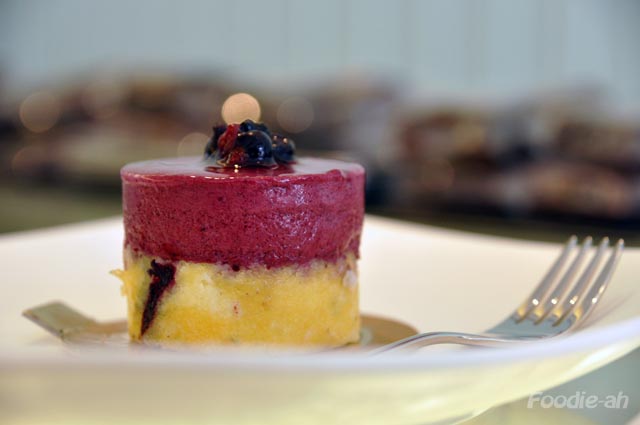 Quite a few patisseries opened recently in Katong, within a fairly small area. I can list a few, in chronological order: Gobi, Obolo, Indulgence, Temptations, Awfully Chocolate, and now Pavé. While Awfully chocolate aims at the mass market and its success is primarily based on its marketing rather than the product, the other patisseries do try to deliver a good product. So what distinguishes Pavé from the rest?
Quite a few patisseries opened recently in Katong, within a fairly small area. I can list a few, in chronological order: Gobi, Obolo, Indulgence, Temptations, Awfully Chocolate, and now Pavé. While Awfully chocolate aims at the mass market and its success is primarily based on its marketing rather than the product, the other patisseries do try to deliver a good product. So what distinguishes Pavé from the rest?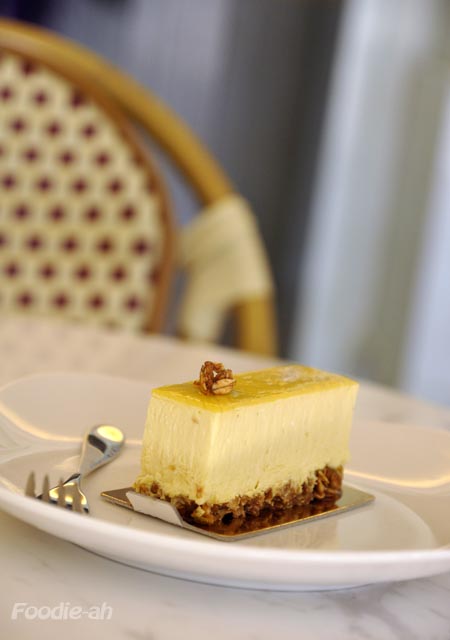 To me, it is quite obvious at a first glance, as you look at the display from outside. The shop provides a full experience from the moment you step in, with its pastel colours and cozy design. It's like stepping into someone's house, except you are in a fairy tale. All the friendly staff working at Pavé are in there for the passion rather than the money. They know the product, and they love talking about patisserie.
To me, it is quite obvious at a first glance, as you look at the display from outside. The shop provides a full experience from the moment you step in, with its pastel colours and cozy design. It's like stepping into someone's house, except you are in a fairy tale. All the friendly staff working at Pavé are in there for the passion rather than the money. They know the product, and they love talking about patisserie.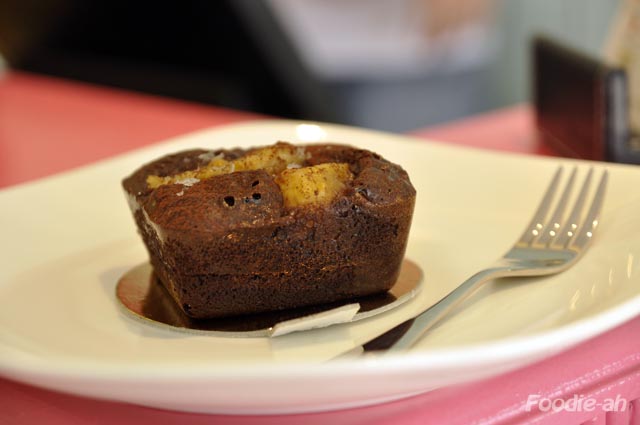 Pavé has only been open for less than a week, and the first experimental batch of desserts is already impressive. I tried the chocolate mousse with coconut and it was fabulous. The cassis mousse with rosemary was also very good, although I am always more impressed by non-fruity flavours. Next on my "to-try"list, is the chocolate/banana dessert pictured above. I heard it's a melt-in-your-mouth experience
Pavé has only been open for less than a week, and the first experimental batch of desserts is already impressive. I tried the chocolate mousse with coconut and it was fabulous. The cassis mousse with rosemary was also very good, although I am always more impressed by non-fruity flavours. Next on my "to-try"list, is the chocolate/banana dessert pictured above. I heard it's a melt-in-your-mouth experience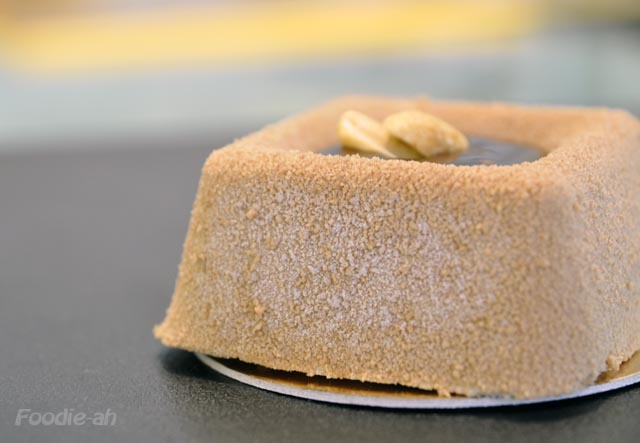 While browsing their display shelves, I came across a few jars of jam and more importantly a jar of salted caramel, which I bought without thinking twice. As I tasted it, and it was as good as I hoped. It is meant to be eaten with bread or croissants, but I love it on its own. It leaves a beautiful flavour lingering in your mouth, with that balanced combination of bitter and salty.
While browsing their display shelves, I came across a few jars of jam and more importantly a jar of salted caramel, which I bought without thinking twice. As I tasted it, and it was as good as I hoped. It is meant to be eaten with bread or croissants, but I love it on its own. It leaves a beautiful flavour lingering in your mouth, with that balanced combination of bitter and salty.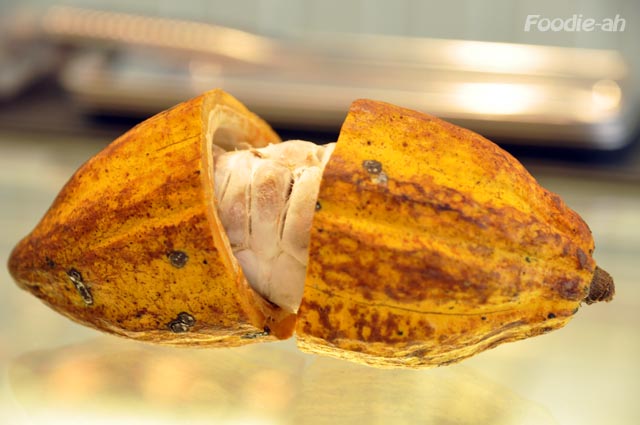 The chocolate brownies are also among the best I have tried so far. Every bite of it almost feels like eating chocolate truffles.
The chocolate brownies are also among the best I have tried so far. Every bite of it almost feels like eating chocolate truffles. At the moment, the display includes 6 types of desserts (3 fruity ones and 3 chocolaty ones), chocolate brownies, beautifully presented chocolates (topped with drawings or nuts / fruits), and a few types of jam.
At the moment, the display includes 6 types of desserts (3 fruity ones and 3 chocolaty ones), chocolate brownies, beautifully presented chocolates (topped with drawings or nuts / fruits), and a few types of jam. They are working on their macarons, which they haven't started selling yet, and they are waiting for some top quality chestnut puree to be delivered from France, before they can start making my favourite desert: the Mont Blanc. With such attention put into the selection of the raw ingredients, I am sure this will be a seriously addictive version of it. I am looking forward to that!
They are working on their macarons, which they haven't started selling yet, and they are waiting for some top quality chestnut puree to be delivered from France, before they can start making my favourite desert: the Mont Blanc. With such attention put into the selection of the raw ingredients, I am sure this will be a seriously addictive version of it. I am looking forward to that! I later discovered that the cozy entrance and display is not all there is to this shop. Well hidden around the corner behind the chairs and tables is an antique looking corridor with more seatings for those who prefer more privacy, and a staircase leads to the upper floor of the shop house where renovation work is still ongoing, but it will eventually provide additional space.
I later discovered that the cozy entrance and display is not all there is to this shop. Well hidden around the corner behind the chairs and tables is an antique looking corridor with more seatings for those who prefer more privacy, and a staircase leads to the upper floor of the shop house where renovation work is still ongoing, but it will eventually provide additional space. A visit to the toilet confirmed my first impression: they do have attention to detail. Even this space had to be matched, and they turned it into a toilet you will want to visit. Sketched on the door, you will notice a 4 cute animals that represent the enthusiastic owners.
A visit to the toilet confirmed my first impression: they do have attention to detail. Even this space had to be matched, and they turned it into a toilet you will want to visit. Sketched on the door, you will notice a 4 cute animals that represent the enthusiastic owners.I get excited when people do things with pride and passion. I get especially excited when this happens right in my neighborhood. I wish Pavé all the success that they deserve.
Pavé
93 East Coast Road
Singapore 428792
Tel: (+65) 6342 0677
Website: http://www.pavechocolates.com/












